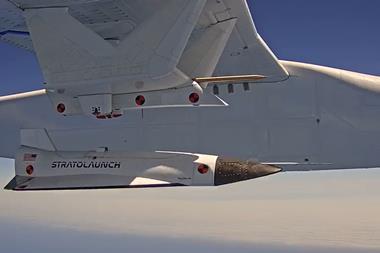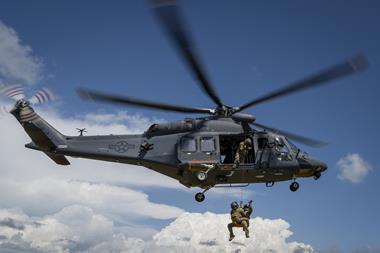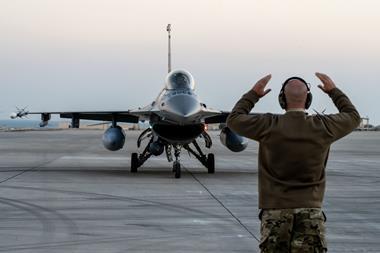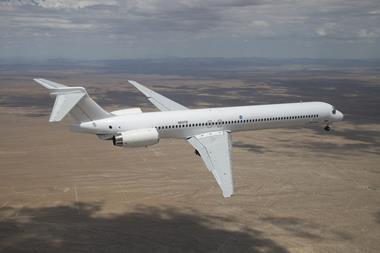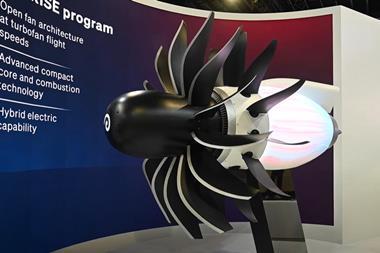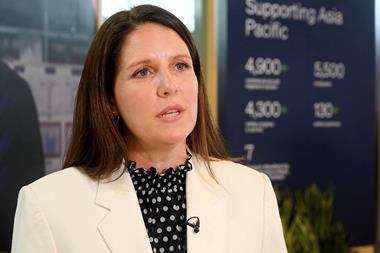Rotorcraft manufacturer Sikorsky has powered up its Raider X prototype for the first time.
The unique compound coaxial aircraft and its GE Aerospace T901 Improved Turbine Engine were both developed for the US Army’s now-cancelled Future Attack Reconnaissance Aircraft (FARA) programme.
Senior officials at the Pentagon, including the army’s chief of staff and civilian secretary, axed FARA in February as part of a broader realignment of aviation fleet strategy.
Although that decision was made before the two FARA prototypes – Sikorsky’s Raider X and Bell’s Invictus 360 – could achieve lift-off, the army has decided to move forward with limited ground testing on the Raider X.
Paul Lemmo, president of Sikorsky, says the Raider X “turned rotors” for the first time on 10 April at Sikorsky’s flight development centre in West Palm Beach, Florida.
Brigadier General David Phillips, the army’s programme executive for aviation, confirms the milestone.

The ground test marked both the first time the Raider X has been powered up and the first time a T901 engine was ignited inside an actual aircraft, rather than a ground test stand.
According to Lemmo, Sikorsky and the army are planning a limited number of Raider X ground tests to gather data on the new T901 engines, which the army eventually plans to integrate into its existing Sikorsky UH-60 and Boeing AH-64 fleets.
“We’re working on tasks with the FARA money that make sense for army aviation,” Lemmo said on 24 April, speaking at the annual US Army aviation summit in Denver, Colorado.
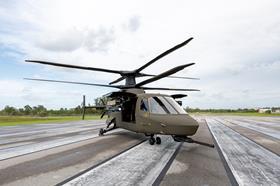
Video provided by Sikorsky shows the compound rotors of the Raider X spinning up amidst a cloud of smoke – the result of transport preservation oil burning off the T901 engine, rather than a mechanical issue.
Lemmo says the first test run saw the engine operate at low power. With that successfully completed, the army has authorised Sikorsky to run the government-owned prototype at full power to collect additional data.
According to Lemmo, the Raider X testing offers Sikorsky a “head start” in the separate effort to install a T901 into a Black Hawk.
“We can have a ground run, see what data measurements we get, and if we learned something negative then GE could go work that,” he notes.
“So far, we haven’t learned anything negative,” he adds, expressing confidence in the engine-maker.
The company has stationed two UH-60s at West Palm Beach as part of the integration effort, but is still waiting to receive the new GE Aerospace powerplants. T901 testing with the Raider X allows some initial evaluations to be performed in the interim.
Sikorsky is already under contract with the army for the Black Hawk modification programme, which includes flight testing with the T901.
“We kind of view the [Improved Turbine Engine programme] as foundational for Black Hawk modernisation,” Lemmo says, noting the new powerplant will deliver improvements to power, range, efficiency and lift.
Sikorsky expects to receive T901 engines for the UH-60 retrofit sometime this summer. Lemmo projects it will take the company six months to complete integration and ground testing, before moving on to flight evaluations.
The integration process does require some modifications to the UH-60, including changes to fuel, hydraulic and electrical connections. Alterations to the engine compartment are also being made, according to specifications from GE Aerospace.
Notably, the ground testing of Raider X does not indicate that either of the FARA prototypes will ever fly.
Both aircraft are owned by the army under the FARA development contracts, and Phillips says there are currently no plans for flight testing.
Bell tells FlightGlobal that it is not in a position to fly its 360 Invictus.
Lemmo says that while the Raider X may never leave the ground, Sikorsky will continue to fly its S-97 Raider demonstrator. That company-owned aircraft is based on the same X2 coaxial technology as the FARA prototype
Although distinct, the Raider X and S-97 share a high level of commonality.
Sikorsky plans to continue pursuing X2-style aircraft, including in the company’s bid for the NATO’s Next Generation Rotorcraft Capability programme – a joint effort between France, Germany, Greece, Italy, the Netherlands and the UK.
















